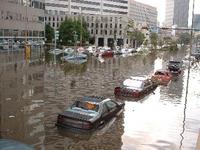The Cars of Katrina and Rita
Yet Another Reason To Wring Our Hands
By Steve Purdy
Detroit Bureau
Perhaps a few months from now you’ll be out car shopping. You’re looking for an economical sedan; something to get you to and from work and all the other obligations and pleasures of life. You’re not averse to a late model used car so you’re exploring that option as well. Suddenly, while browsing a used car lot, you find a luxury sedan, perhaps a Lexus, BMW or Cadillac, for the price you were expecting to pay for an Impala.
“Watch out!” warns Jack Kain chairman of the National Automobile Dealers Association, which represents approximately 2000 US dealers with nearly 43,000 domestic and foreign car and truck franchises. You’ll likely know the NADA from their famous Blue Book guide to used car prices. NADA is worried about cars and trucks badly damaged by the hurricanes making their way into the steam of automotive commerce around the country.
Kain, a Kentucky Ford dealer as well as NADA boss, presented worrisome scenarios to a gathering of the Automotive Press Association in Detroit this week. As insurance companies gather up ruined cars they auction them to “vultures” who dry them out and clean them up only as good as they have to then sell them to unsuspecting individuals or dealers in other parts of the country.
What’s the problem with these cars?” you might ask. Well, once a car is flooded it is virtually impossible to put it right, no matter how much time, effort and money goes into the project. Water, salt water particularly, will permeate everything - wiring, fabrics, body panels, mechanical parts, electronic units, and everything else - causing corrosion, mildew, and all manner of problems. Since many of the problems don’t show up right away the miscreant has time to move the car before anyone is the wiser.
Many cars flooded by Hurricane Katrina sat in sewage-tainted water for many days making them even more dangerous. These biological contaminants cannot be gotten rid of and most of these cars need to be simply gathered up and recycled, Kain warned.
Kain and the NADA are supporting a partial solution to the problem, along with their lobbyists in Washington, that would require a car’s title to be “branded” or red flagged indicating the car is “flood damaged”, or “non-repairable” or some other description. We’ve all heard of a “salvage” title. Well, this is very similar. A permanent notation is affixed to the car’s title designating its status. The problem is that different states have different definitions or red flags that don’t always follow the car from state to state.
NADA’s solution would have a national database of VIN numbers available that could be researched before a purchase decision is made. “The technology . . . already exists,” Kain said. “Companies such as Carfax and Experian use it every day.” State departments of motor vehicles would be required to make accurate, timely information available and, of course, the data would have to be uniform in terms of the red flags and their definitions. Kain was careful to assure the audience that data on car owners need not be a part of the database. Most states have privacy laws to prevent that anyway.
“It’s really an issue of title fraud,” insists Kain. “ . . . we will all benefit when complete title information gets to dealers and consumers more quickly. The integrity of the entire system is at stake. The more transparent we can make the title process, the higher the cost for those who would commit title fraud.”
In the meantime, Kain and the NADA offer these tips to help prospective buyers avoid purchasing a flood-damaged car or truck:
• Examine the interior and the engine compartment for evidence of water and grit from suspected submersion;
• Check for recently shampooed carpet;
• Look under the floorboard carpet for water residue or stain marks from evaporated water not related to air-conditioning pan leaks;
• Inspect for rusting on the inside of the car and under interior carpeting and visually inspect all interior upholstery and door panels for any evidence of fading;
• Check under the dashboard for dried mud and residue, and note any evidence of mold or a musty odor in the upholstery, carpet or trunk;
• Check for rust on screws in the console or other areas where the water would normally not reach unless submerged;
• Look for mud or grit in alternator crevices, behind wiring harnesses and around the small recesses of starter motors, power steering pumps and relays;
• Complete a detailed inspection of the electrical wiring system looking for rusted components, water residue or suspicious corrosion; and
• Inspect the undercarriage of other components for evidence of rust and flaking metal that would not normally be associated with late model vehicles.
While these inspection suggestions will not detect flood damage in every case, they do provide some information that may help to protect consumers from purchasing a vehicle damaged by water or flood.
Be An Aware Consumer.



